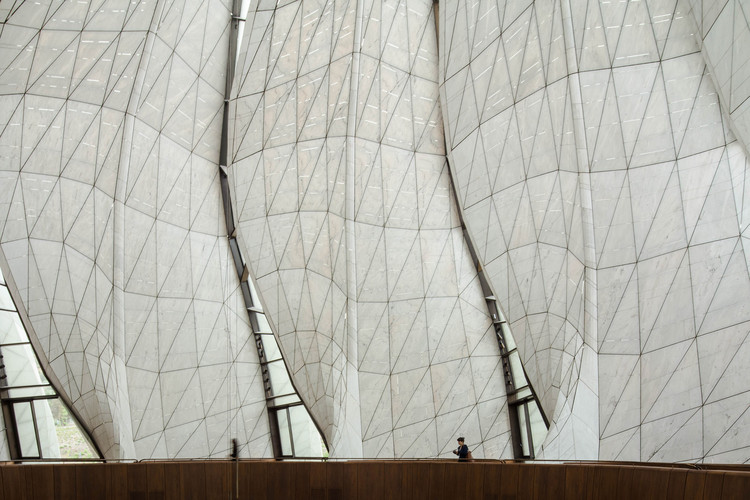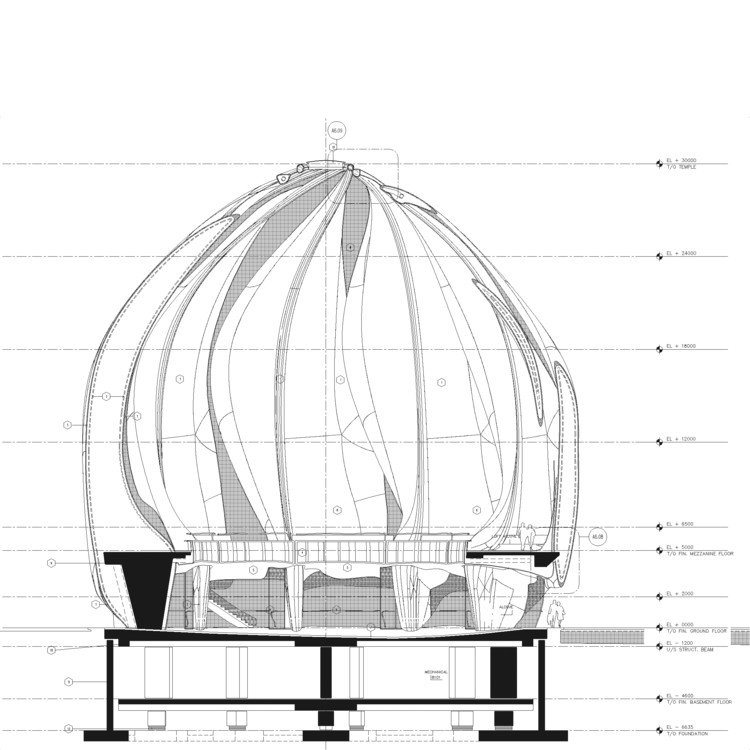
-
Architects: Hariri Pontarini Architects
- Area: 1200 m²
- Year: 2016
-
Photographs:Daniela Galdames
-
Manufacturers: CHC, Contemporary Glass Designs, European Windows, Limarí Lighting Design, Mathiesen, Nuprotec, Tecpro
-
Lighting Consultant: Isometrix, Limarí Lighting Design
-
Structural Consultants: Simpson Gumpertz & Heger, Patricio Bertholet M.
-
Structural Assistance: TROW/Carruthers & Wallace, Universidad de Toronto, Sirve S.A., DICTUC - Pontificia Universidad Católica de Chile., Carl Lüders, Juan Carlos de La Llera

Text description provided by the architects. A temple of light expressing a faith of inclusion is poised to become an architectural landmark in Chile. Set within the Andean foothills just beyond the metropolis of Santiago, the complex- curved temple is designed by the distinguished Canadian architect Siamak Hariri as an invitation for spiritual contemplation and architectural pilgrimage.

Surrounded by reflecting pools and a landscape of native grasses, the Bahá’í Temple of South America is a domed, luminous structure that echoes the rolling topography of the Andes while appearing to oat some 30 metres above the earth. Its nine monumental glass veils frame an open and accessible worship space where up to 600 visitors can be accommodated on curved walnut and leather seating. Looking up to the central oculus at the apex of the dome, visitors will experience a mesmerizing transfer of light from the exterior of cast glass to an interior of translucent Portuguese marble. At sunset, the light captured within the dome shifts from white to silver to ochre and purple.

Fourteen years in the making, the South American House of Worship represents the last of the eight continental temples to be completed as part of a remarkable portfolio of landmark sacred architecture commissioned by the Bahá’í Community. The temple will be unveiled on its stunning 10-hectare site outside of Santiago in mid-October, 2016 with a series of press and public events.



Without ritual or clergy, without icons or images, Bahá’í Temples are conceived to reflect an ideal of universal worship where women, men and children can gather together as equals. The Bahá’ís believe in the critical role of volunteerism (known as service) to heighten their prayer and reflection within a House of Worship. In time, universities and hospitals are to be erected in proximity to the temples. In Chile, connecting to the community has inspired the repurposing of an existing golf clubhouse on the property into an education centre for youth.
Openness and transparency are fundamental to both the structure and its site. The Bahá’í House of Worship can be accessed by nine entrances located at regular intervals around the domed structure, while curving paths lead visitors on walking meditations through the sloped landscape. The acclaimed Chilean landscape architect,Juan Grimm, has transformed a barren golf course into a lush, colourful landscape planted with native, drought-resistant varieties that extend generously around the temple. According to Grimm’s landscape design and working in partnership with the Municipality of Peñalonen, the Bahá’ís are planting native Quillay trees to support an environmental program called “Crece Verde” or “Green Growth”. In total, more than 6000 trees have been planted or are currently growing in a nursery established for the temple landscape.



Visitors to the spectacular site will be amazed first by the epic scale of the surrounding Andes. Walking toward the House of Worship up stone stairs and along pathways visitors will experience gardens that foreground the temple. As the path cuts between a rise in the landscape, the temple disappears momentarily only to reappear alongside a monumental reflecting pool. Standing next to the temple, visitors will appreciate the complex subtlety of the exterior cladding manufactured from melted glass that recalls the configuration of snowflake crystals.
Access to the mountain site was previously di cult. To open the House of Worship to all peoples as a place of prayer and meditation, the Bahá’ís have invested significantly to build a new road to the site, allowing for easy access for locals visiting from Santiago. Of the new South American temple, Francisco Chahuán, Senator of the Republic of Chile said: “I have no doubt that this place is destined to be a center of prayer, meditation and gathering, that will also invite all of the inhabitants of Peñalolén and the whole country to seek a place of tranquility and introspection.”

Designing a structure as complex and varied as nature required the most advanced computer technology. Led by Siamak Hariri, the team at Hariri Pontarini Architects innovated its own system of rendering the sculptural building, using machine-to-machine fabrication to create highly irregular, organic shapes in glass.





































